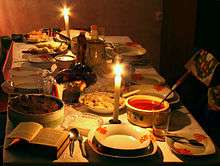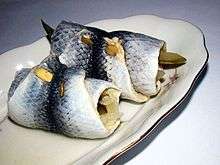Wigilia


Wigilia (Polish pronunciation: [viˈɡilʲa]) is the traditional Christmas Eve vigil supper in Poland, held on December 24. The term is often applied to the whole day of the Christmas Eve, extending further into Pasterka, the midnight Mass held at Roman Catholic churches all over Poland and in large Polish communities worldwide at midnight preceding the Christmas Day. In this usage, the supper itself is rather called "wieczerza" or "wieczerza wigilijna", using an Old Polish word meaning "dinner" or "large supper", stemming from Proto-Indo-European root *vesper - "evening". The Last Supper translates into Polish as "ostatnia wieczerza".
The word Wigilia derives from the Latin verb vigilare, "to watch", and literally means "eve". The feasting traditionally begins once the First Star has been sighted (usually by children) in the heavens at dusk (around 5 p.m.).[1] Therefore, Christmas is also sometimes called "Gwiazdka" (the little star, referring to the Star of Bethlehem).
Traditions and customs
Children usually decorate the Christmas tree on this day (if it has not been set up before). Often a bundle of hay is placed under the tablecloth or in each of the four corners of the room to symbolize the fact that Jesus was born in a manger.
As a game, children would remove pieces of straw from under the table. Green would mean a year of wealth or possibly a marriage, while a black piece of hay would mean bad luck much like the "piece of coal" represents in modern Christmas lore. The drawing of hay was only for fun and was rarely paid attention to. Various other divinations are semi-seriously practiced such as hiding a nut (or another small food piece) in a cake and dividing it among family members. Whoever finds the nut inside his portion is guaranteed to have a successful year.
Another tradition practiced by some, is to leave one extra place-setting for an "unexpected guest". This is to celebrate the tradition of hospitality and inclusion. The empty seat is left open just in case a traveler, family member, or a friend knocks on the door, so there would be a place for them to join in the celebrations.
Family members begin the celebration with a prayer and breaking of the Christmas wafer (opłatek - symbolizing the bread eaten daily — our day-to-day common life; very old Christian tradition of sharing bread) and wishing each other good fortune in the upcoming new year. (After the prayer, usually done by the man of the house, the opłatek is broken and pieces are given to everyone attending the table. From there, everyone breaks off a piece of their opłatek, and shares it with everyone else, wishing luck and joy in the upcoming year, for Christ has been born. This wish is usually finalized by a kiss on the cheek.) Readings from the Bible concerning the nativity of Jesus are practiced in more religious households. In the countryside, it is customary to feed livestock (though not dogs, cats, and other pets) with the wafer, as the animals of the household are to be treated as people that day and are traditionally believed to speak with a human voice at midnight.
The evening Supper
After the First Star appears in the sky and after sharing the Christmas wafer (opłatek), the Supper begins. A traditional Christmas meal in Poland includes fish dishes and Borscht (beetroot soup) with Uszka (tortellini). Fish provides a main component of the Christmas Eve meal across Poland; since 1940 more popular are carp fillet, carp in aspic etc. Wigilia is observed as a Black Fast meaning that most Poles abstain from eating meat on this day. Many households also prepare a great variety of special Christmas rollmops, matjas herring, poppy seed cakes (makowiec), dried fruit compote and other delicacies including edible Christmas ornaments. Common dishes are various fruits (dried apples, plums, apricots, dates, etc.) and salads. Regional dishes include żurek, siemieniotka (in Silesia), mushroom soup, different salads, pierogi filled with cheese and potatoes as well as cooked dried mushrooms and cabbage (kapusta) or cabbage and yellow peas; stuffed cabbage with mushrooms and rice gołąbki (cabbage rolls), kluski with poppyseed, kutia, and makówki (in Silesia).
It is still believed that whatever happens on Wigilia affects the following year. So, if a quarrel should arise, it foretells a quarrelsome and troublesome year.
The number of country courses is traditionally established to be either twelve or an odd number (in Silesia); Twelve is symbolic of the number of months in the year as well as to celebrate the twelve disciples of Jesus.
The Shepherd's Mass
Some families as well as individual worshippers attend the traditional midnight mass/Shepherd's Mass (pasterka), where Christmas carols are also sung.
A major part of the Wigilia festivities is the opening of gifts. The children often open their gifts and hand out the gifts for the adults from under the tree. The gift-giver in Polish tradition is the Gwiazdka – Saint Nicholas' feminine counterpart – or the Gwiazdor (masculine), which is either a Pagan tradition, or represents the little Star of Bethlehem. Saint Nicholas brings gifts on December 6. However this varies and in some families Saint Nicholas is said to bring presents both on the 6th and on Christmas.
The Christmas breakfast
Christmas Day is a national holiday in Poland and most Poles spend the day feasting with their family. Followed by Christmas Eve (Wigilia) there are two more days of Christmas celebration. Christmas breakfast often consists of scrambled eggs, cold-cuts served with horseradish sauce, smoked or fried salmon, marinated salads, coffee, tea and cakes, i.e. poppy seed roll, gingerbread (piernik) cake and cookies, kutia, etc.
| Wikimedia Commons has media related to Christmas food of Poland. |
References
- Wigilia article from the Polish American Center
- Wigilia article from Pope John Paul II Polish Center
- Wigilia article from the Polish Museum of America
